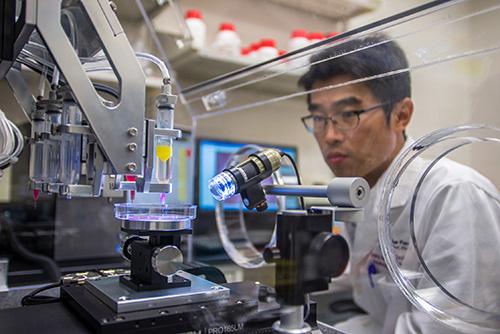 About a year ago, researchers at the Wake Forest Institute for Regenerative Medicine (WFIRM) announced that they had successfully transplanted functional 3D printed tissue into animals. The 3D printed ear, bone and muscle structures, once implanted, matured into functional tissue and grew new blood vessel systems – a major breakthrough in the bioprinting and tissue engineering world. While that news has understandably garnered a great deal of attention, Wake Forest has also been working on some other bioprinting research that could have huge implications for healing.
About a year ago, researchers at the Wake Forest Institute for Regenerative Medicine (WFIRM) announced that they had successfully transplanted functional 3D printed tissue into animals. The 3D printed ear, bone and muscle structures, once implanted, matured into functional tissue and grew new blood vessel systems – a major breakthrough in the bioprinting and tissue engineering world. While that news has understandably garnered a great deal of attention, Wake Forest has also been working on some other bioprinting research that could have huge implications for healing.
Along with organs such as the heart, liver and kidneys, the skin has been a major area of focus for bioprinting researchers. Many experts believe that functional 3D printed skin will be a reality very soon, and that’s incredible news for burn victims and others suffering from severe skin damage or disease. At Wake Forest, the development of 3D printed skin is only one part of what the institute’s scientists are trying do as part of the Armed Forces Institute of Regenerative Medicine (AFIRM), a $75 million, federally funded project aimed at developing regenerative medicine technology to be applied to battle-related injuries.

Young-Joon Seol of WFIRM works with a 3D printer to produce muscle tissue for facial reconstruction. [Image: WFIRM]
- Skin regeneration for burn injuries
- Restoring function to severely traumatized limbs
- Reconstruction for facial and skull injuries through tissue regeneration
- New treatments to prevent rejection of “composite” transplants such as face and hands
- Reconstruction of the genital and urinary organs and lower abdomen
 Not surprisingly, much of the research into these areas involves 3D printing. The WFIRM team is working with the 3D printing of complex tissue components such as bone, nerves, blood vessels, fat and muscle for face and skull reconstruction – an urgent need due to the frequency and severity of craniofacial injuries from explosions and high-velocity projectiles. In addition, WFIRM is deep into the development of a technology that involves printing new skin cells directly into burns and other serious skin injuries.
Not surprisingly, much of the research into these areas involves 3D printing. The WFIRM team is working with the 3D printing of complex tissue components such as bone, nerves, blood vessels, fat and muscle for face and skull reconstruction – an urgent need due to the frequency and severity of craniofacial injuries from explosions and high-velocity projectiles. In addition, WFIRM is deep into the development of a technology that involves printing new skin cells directly into burns and other serious skin injuries.
Normally, medical professionals treat severe burns by taking healthy skin from elsewhere on the body and grafting it onto the wound as a protective cover. However, extensive burn damage limits the amount of skin available for grafting, so it’s not always an effective or even feasible method of treatment. During phase one of the AFIRM project, scientists at WFIRM designed, built and tested a printer capable of printing skin cells directly onto burn wounds. The cells that make up the printing material, or ink, include multiple types of skin cells – a custom mix based on the nature of the wound being treated.
A scanner is used to scan the wound, recording its exact size and depth; the depth is particularly important as different types of skin cells are found in each layer of skin. The scan data then instructs the printer as to which types of cells to apply to each layer of the new printed skin, which would be extruded directly onto the wound. Unlike traditional skin grafts, the printer only requires a skin sample one tenth of the size of the burn to grow enough new cells for printing.
While the printer is still at the prototype stage, clinical trials on mice and pigs have been successful, and the researchers are now waiting for approval to conduct human trials. They’re also exploring whether stem cells from amniotic fluid and placenta can be used to effectively heal wounds, which would eliminate the need to take any skin cells from the patient. Wake Forest hopes that they can begin using the technology to help wounded soldiers within the next five years. Discuss in the Wake Forest forum at 3DPB.com.
Subscribe to Our Email Newsletter
Stay up-to-date on all the latest news from the 3D printing industry and receive information and offers from third party vendors.
You May Also Like
3D Printing News Briefs, April 13, 2024: Robotics, Orthotics, & Hypersonics
In 3D Printing News Briefs today, we’re focusing first on robotics, as Carnegie Mellon University’s new Robotics Innovation Center will house several community outreach programs, and Ugogo3D is now working...
Rail Giant Alstom Saves $15M with 3D Printing Automation Software 3D Spark
3D Spark has entered into a three-year deal with the rail giant Alstom. Alstom, a transport behemoth with annual revenues of $16 billion, specializes in the manufacture of trains, trams,...
Meltio Expands Global Reach with New Partnerships in the Americas and Europe
Spanish 3D printing manufacturer Meltio has expanded its sales network across the globe. With the addition of three new partners in the United States, Brazil, Argentina, and Italy, Meltio aims...
3D Printing Webinar and Event Roundup: April 7, 2024
Webinars and events in the 3D printing industry are picking back up this week! Sea-Air-Space is coming to Maryland, and SAE International is sponsoring a 3D Systems webinar about 3D...
































